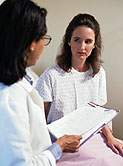
TUESDAY, July 20 (HealthDay News) — In an effort to improve patient-doctor communication, researchers are launching a pilot program in which approximately 25,000 patients will have access to notes their doctors have made in their medical records.
The “OpenNotes” initiative has enrolled 100 primary-care doctors in Massachusetts, Pennsylvania and Washington state to participate for a 12-month test period starting this summer.
“It’s a very innovative project which really has the potential to shift the paradigm with the way clinicians and patients communicate with each other,” said Dr. Christine Laine, editor of Annals of Internal Medicine. A description of the project appears in the July 20 issue of the journal.
Patients have had the legal right to review doctors’ notes since 1996, under the federal Health Insurance Portability and Accountability Act (HIPAA), but few do.
The new initiative coincides with a nationwide push for electronic medical records, not to mention the migration toward the Internet as a preferred source of information and communication.
“Largely, the conversation around electronic medical records has been on whether it can improve the quality of care, decrease medication errors, all of those things,” Laine said. “This group [behind the pilot project] is looking into whether the availability of electronic records is going to allow a major shift in how doctors and patients communicate and how patients access their own medical information.”
“I think it really has the potential to improve, and maybe complicate, but certainly change the way that we communicate,” she said.
One of the most frequent objections expressed by doctors is how much this approach would cut into their time.
“They were most worried about what this would do to their time, worried that they’ll be swamped with questions from patients,” said study co-author Jan Walker, an instructor in medicine at Harvard Medical School and Beth Israel Deaconess Medical Center in Boston.
But this may not turn out to be the case.
A lot of time-consuming interactions that used to take place on the phone may now be dispensed with just by logging onto secure Internet portals used for the trial.
“If a patient wants to know his last HDL cholesterol level, he or she can log onto the Internet. They don’t have to call the doctor, leave a message in the office. So this might cut down on other types of communication, and maybe the communication will become more substantive and less administrative,” Laine said.
Both patients and doctors expressed initial worry that OpenNotes might lead to confusion and anxiety on the part of a patient if, for instance, the patient didn’t understand something in the notes or saw that cancer had been included on a list of possible explanations for their symptoms.
But, this could force doctors to be clearer and more careful in how they express themselves in their notes.
“I might try to simplify things, like use fewer abbreviations [for instance, not many patients know that ‘SOB’ stands for ‘shortness of breath’] and be careful when I address sensitive issues like obesity and substance use and sexual practices,” Laine said. “You would have to document those things in a way that would decrease the chances that patients would be offended or confused.”
The research team will be surveying both patients and physicians before and after the initiative is implemented and will also be scouring “patterns of utilization and computer use,” Walker said.
Researchers will assess expectations before the project begins, then get feedback on actual experiences after the 12 months are over.
The main question the investigators are seeking to answer is whether or not doctors and patients want to continue the trial.
The study authors predicted that one day patients might even be able to view video recordings of their doctor’s visit
More information
Tell what you think about the OpenNotes project on the Annals of Internal Medicine Web site.

